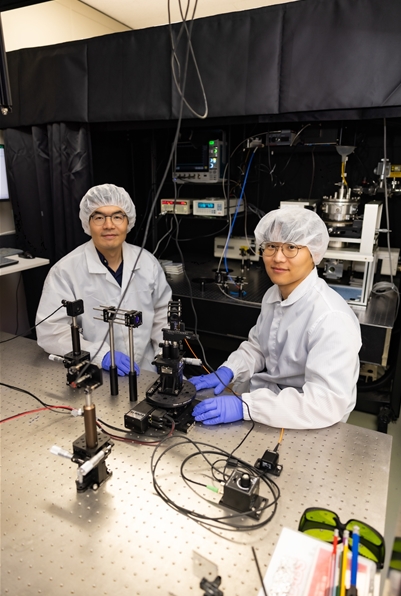- Verified interfacial exciton-polaron quenching, suggesting potential for improving OLED efficiency and lifespan
- Published in the world-renowned physics journal Physical Review X

▲ (From left) Prof. Jaesang Lee (corresponding author), SNU Department of Electrical and Computer Engineering, Doctoral Student Kwangmo Yang (first author), Dr. Ji Whan Kim, SAIT (corresponding author)
Seoul National University (SNU) College of Engineering announced that Professor Jaesang Lee’s research team from the Department of Electrical and Computer Engineering, in collaboration with Samsung Electronics SAIT (Samsung Advanced Institute of Technology), has identified a critical mechanism behind the performance degradation of Organic Light-Emitting Diodes (OLEDs).
The research findings were published on October 10 in Physical Review X, a globally respected physics journal. Physical Review X is a leading open-access journal from the American Physical Society, publishing around 200 key findings annually across all fields of physics. The journal has a strict review process, and it is particularly noteworthy that a Korean research institution has published a paper in the engineering field in this journal, marking a rare and significant achievement.
OLEDs are currently utilized in the displays of major IT devices such as smartphones, tablets, watches, and TVs. In the near future, their application is expected to expand to virtual reality, automotive displays, and flexible/stretchable displays, positioning OLEDs as a key national strategic technology. However, a major technological barrier that impedes the industrial growth of OLEDs is their limited light-emitting efficiency, operational lifespan, and the resulting burn-in phenomenon. To overcome these challenges, the SNU-SAIT research team proposed and experimentally verified the existence of a key factor causing OLED performance degradation: the interfacial exciton-polaron quenching mechanism.
OLEDs are designed with multiple layers of organic semiconductor thin films, where injected positive and negative charges form excitons (electron-hole pairs), and these excitons emit light through radiative recombination. A fine energy barrier exists between the light-emitting layer and adjacent charge transport layers, which hinders charge injection and causes charge accumulation at the interface. The joint research team theoretically proposed a mechanism where excitons in the light-emitting layer are quenched by the accumulated charges at the interface, and they named this phenomenon "interfacial exciton-polaron quenching." They then devised experiments to independently observe this phenomenon, identifying three key factors: interfacial barrier, exciton-polaron distance, and exciton lifetime. The team discovered that this phenomenon occurs universally, regardless of the color of the OLED’s emitted light (red, green, or blue), or the type of emission mechanism (phosphorescence, fluorescence, delayed fluorescence), making it a decisive factor in the reduction of device efficiency. By controlling this phenomenon, the team achieved an increase in efficiency of over 50% for red, green, and blue phosphorescent OLEDs and extended the lifespan of blue OLEDs by more than 70%.

▲ (Upper left) Schematic showing exciton quenching due to polaron accumulation at the interface of the OLED light-emitting layer and adjacent charge transport layer
(Lower left) 3D contour plot showing the intensity of interfacial exciton-polaron quenching depending on interfacial energy barriers and exciton-polaron distances
(Right) Exciton-polaron quenching intensity based on interfacial energy barriers, exciton-polaron distances, and light emission mechanisms
The discovery by the joint research team is seen as a significant achievement that challenges the conventional understanding in the OLED academic and industrial communities, which previously believed that exciton-polaron quenching occurred only within the light-emitting layer. This study demonstrated for the first time that this phenomenon occurs across the heterogeneous interface between the light-emitting layer and the charge transport layer, critically reducing OLED performance. Professor Jaesang Lee commented, “Interfacial exciton-polaron quenching is a phenomenon that must be overcome to commercialize blue OLEDs, which have relatively lower efficiency and shorter lifespans. Therefore, this study is expected to contribute to future research and development of blue OLEDs.”
Meanwhile, the first author of the paper, PhD student Kwangmo Yang, is conducting follow-up research to significantly enhance the lifespan of blue OLEDs under the guidance of Professor Lee. This research was supported by Samsung Electronics SAIT, the National Research Foundation of Korea, the Korea Institute of Industrial Technology Evaluation and Planning, and the BK21 Program.

▲ Photo of the Intelligent Display and Sensor Laboratory at SNU's Inter-University Semiconductor Research Center
(Left: Prof. Jaesang Lee, corresponding author, Dept. of Electrical and Computer Engineering, SNU; Right: PhD Student Kwangmo Yang, first author)
[References Materials]
▶ Title: Interfacial Exciton-Polaron Quenching in Organic Light-Emitting Diodes
▶ Journal: Physical Review X
▶ First Author: Kwangmo Yang (SNU)
▶ Corresponding Authors: Jaesang Lee (SNU), Ji Whan Kim (SAIT)
[Contact Information]
Prof. Jaesang Lee, Department of Electrical and Computer Engineering, SNU / +82-2-880-9093 / jsanglee@snu.ac.kr

